Price: Starts from ₹ 45,000
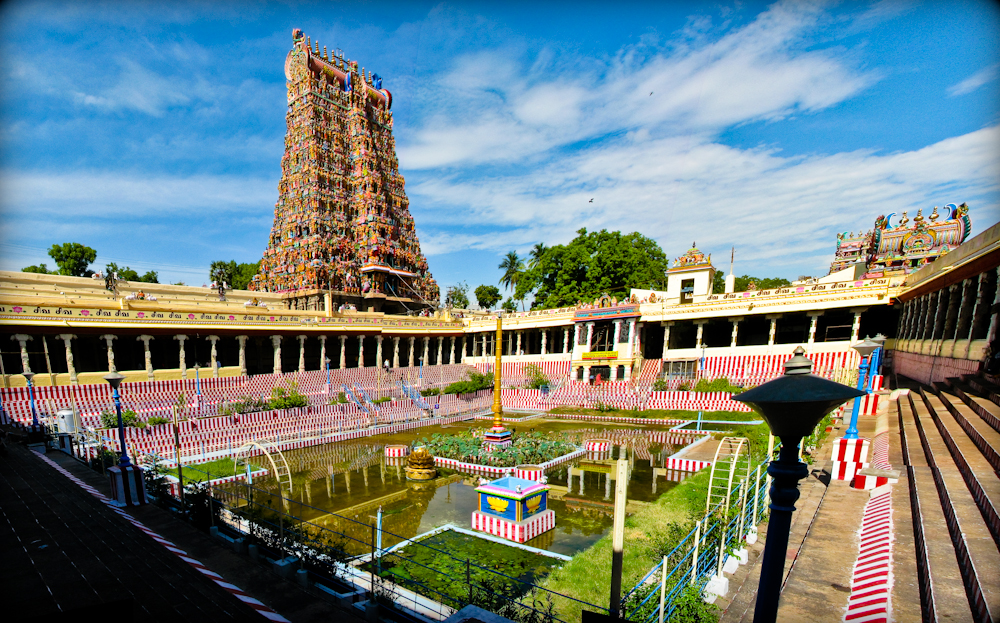
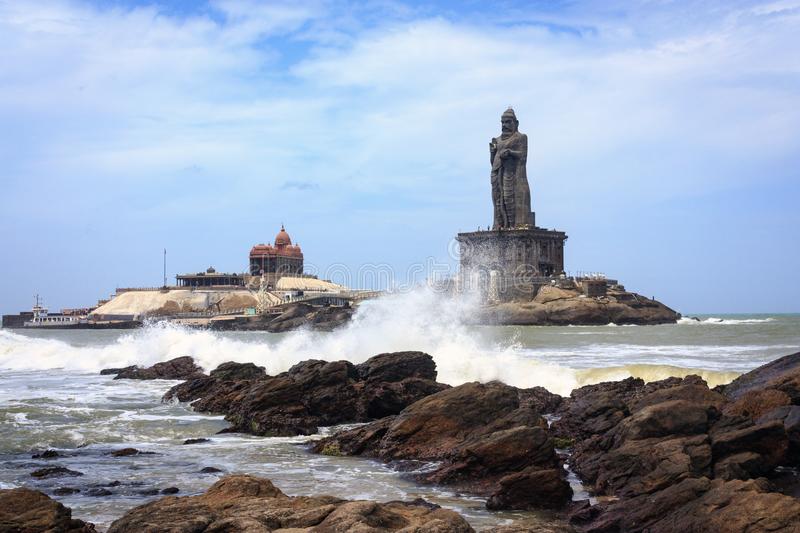
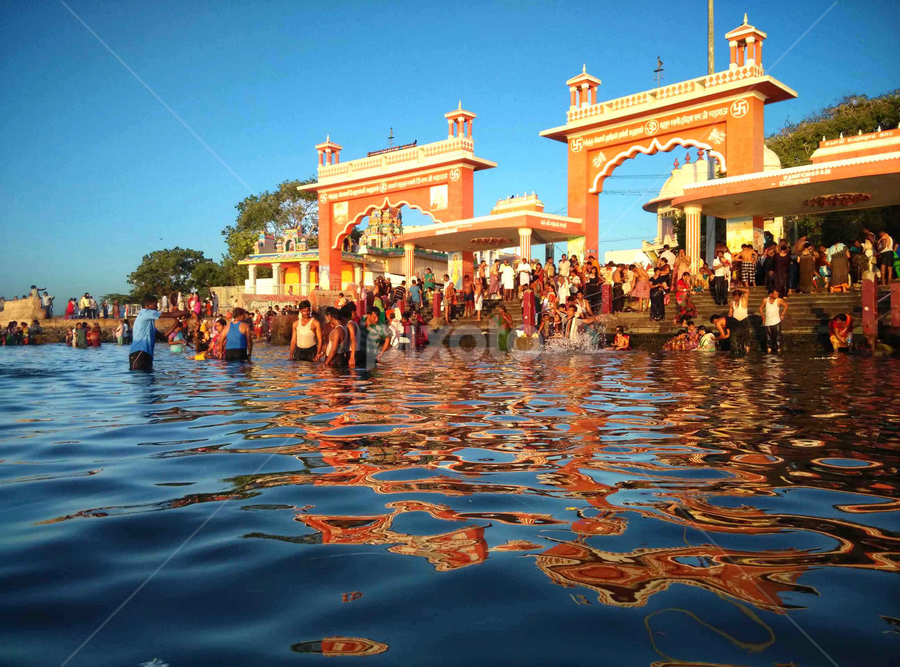
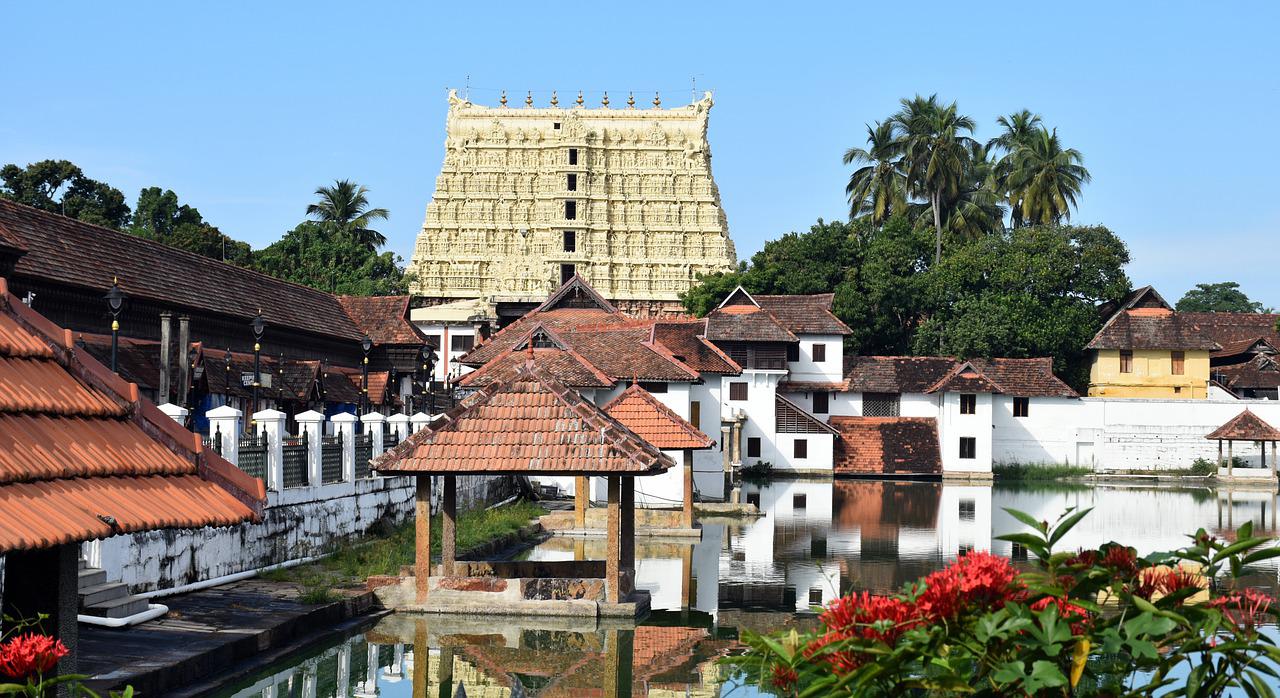
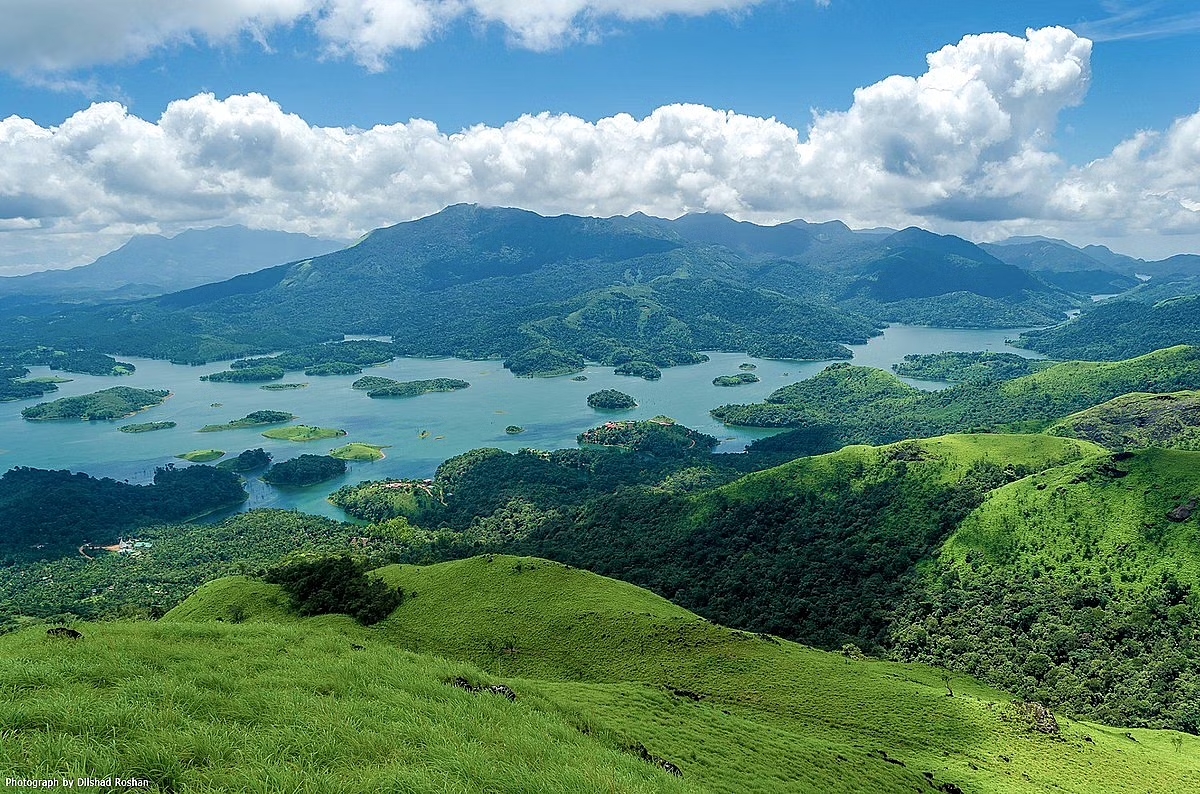





| Departure Dates | 2026: JAN 22. FEB 5, 19. MAR 5, 19. APR 2, 16, 30. MAY 7, 21. JUN 4, 18. JUL 9, 23. AUG 6, 20. SEP 10, 24. OCT 8, 22. NOV 12, 19, 26. DEC 5, 12, 19. |
|---|---|
| Tour Code | SIT 10 |
| EX | Bengaluru |
| Vehicles Used | Deluxe Bus |
| Duration | 10 Days |
| States/Countries Visited | Tamilnadu, Kerala, Karnataka |
| Places Visited | Kancheepuram, Chidambaram, Kumbhakonam, Thanjavur, Srirangam, Rameshwaram, Madurai, Kanyakumari, Nagarkoil, Suchindram, Thiruvananthapuram, Kalady, Guruvayur, Nanjangudu |
| Best Time To Visit | all season |
Kanchipuram
Kanchipuram also known as Kanjeevaram, is a city in the Indian state of Tamil Nadu known as the City of Thousand Temples, Kanchipuram is known for its temple architectures, 1000-pillared halls, huge temple towers and silk saris. Kanchipuram is a Sanskrit word formed by combining two words "Kanchi" and "-puram" meaning "Brahma worship" and "residential place" respectively and located on the banks of the Vegavathy and Palar river. Kanchipuram has been ruled by the Pallavas, the Medieval Cholas, the Later Cholas, the Later Pandyas, the Vijayanagara Empire, the Carnatic kingdom, and the British, who called the city "Conjeeveram". The city's historical monuments include the Kailasanathar Temple and the Vaikunta Perumal Temple. Historically, Kanchipuram was a centre of education and was known as the ghatikasthanam, or "place of learning". The city was also a religious centre of advanced education for Jainism and Buddhism between the 1st and 5th centuries.
Chidambaram
Chidambaram is a town in the Indian state of Tamil Nadu, on the banks of the Vellar River where it meets the Bay of Bengal. The town is believed to be of significant antiquity and has been ruled, at different times, by the Pallavas until ninth century, Medieval Cholas, Later Cholas, Later Pandyas, Vijayanagara Empire, Thanjavur Nayakas, Marathas and the British. The town is known for the Thillai Nataraja Temple and Thillai Kali Temple, and the annual chariot festival held in the months of December–January (In the Tamil month of Marghazhi known as "Margazhi Urchavam") and June to July (In the Tamil month of Aani known as "Aani Thirumanjanam"). One of the Divya Desams Divya Sri Govindaraja Perumal Temple (Thiruchitrakoodam) is a part of Thillai Nataraja Temple complex. Thiruvetkalam Shiva Temple, Vadakiruppu, Thirunelvayil Shiva Temple, Sivapuri and Tirukkazhippalai Palvannanathar Temple are the other three ancient Shiva temples in the region.
Kumbakonam
Kumbakonam, or Kudanthai, is a city in the Thanjavur district in the Indian state of Tamil Nadu. The city is bounded by two rivers, the Kaveri River to the north and Arasalar River to the south. Kumbakonam is known as a "Temple town" due to the prevalence of a number of temples here and is noted for its Mahamaham festival, which happens once in 12 years, attracting people from all over the country. The name "Kumbakonam", is believed to be an allusion to the mythical pot (kumbha) of the Hindu god Brahma that contained the seed of all living beings on earth. The kumbha is believed to have been displaced by a pralaya (dissolution of the universe) and ultimately came to rest at the spot where the town of Kumbakonam now stands.
Thanjavur
Thanjavur, also known as Thanjai, previously known as Tanjore, is a city in Tamil Nadu. Thanjavur is an important center of South Indian religion, art, and architecture. Most of the Great Living Chola Temples, which are UNESCO World Heritage Monuments, are located in and around Thanjavur. The foremost among these, the Brihadeeswara Temple, built by the Chola emperor Rajaraja I, is located in the centre of the city. This temple has one of the largest bull statue in India carved out of a single granite rock called Nandi. Thanjavur is also home to Tanjore painting, a painting style unique to the region.
Srirangam
Srirangam is a neighborhood in the city of Tiruchirappalli in the Indian state of Tamil Nadu. A river island, Srirangam is bounded by the Kaveri River on one side and its distributary Kollidam on the other side. Considered as the first among the 108 Divya Desams, a group of Vishnu temples, it is famous for the Sri Ranganathaswamy Temple, the largest temple complex in India and the biggest functioning Hindu temple in the world. Srirangam is also home to a significant population of Sri Vaishnavas (followers of Vishnu).
Rameswaram
Rameswaram in the Ramanathapuram district of the Indian state of Tamil Nadu. It is on Pamban Island separated from mainland India by the Pamban channel. Pamban Island, also known as Rameswaram Island, is connected to mainland India by the Pamban Bridge. Together with Varanasi, it is considered to be one of the holiest places in India to Hindus and is part of the Char Dham pilgrimage. According to the Ramayana, Rama is described to have built a bridge from the region approximating this town across the sea to Lanka to rescue his wife Sita from her abductor Ravana. The temple, dedicated to the Hindu god Shiva, is at the centre of the town and is closely associated with Rama and Shiva. The temple and the town are considered a holy pilgrimage site for Shaivas and Vaishnavas. Rameswaram means "Lord of Rama" in Sanskrit, an epithet of Shiva, the presiding deity of the Ramanathaswamy Temple. According to Hindu epic Ramayana, Rama, the seventh avatar of the god Vishnu, prayed to Shiva here to absolve any sins that he might have committed during his war against the demon-king Ravana in Sri Lanka.
Madurai
Arulmigu Meenakshi Sundaraswarar Temple a.k.a Arulmigu Meenakshi Amman Thirukkovil is a historic Hindu temple located on the southern bank of the Vaigai River in the temple city of Madurai, Tamil Nadu, India. It is dedicated to the goddess Meenakshi, a form of Shakti, and her consort, Sundareshwarar, a form of Shiva. The temple is at the centre of the ancient temple city of Madurai mentioned in the Tamil Sangam literature, with the goddess temple mentioned in 6th-century CE texts. This temple is one of the Paadal Petra Sthalams, which are 275 temples of Shiva that are revered in the verses of Tamil Saiva Nayanars of the 6th-9th century CE.
Kanyakumari
Kanniyakumari, referring to Devi Kanya Kumari, is a city in Kanniyakumari district in the state of Tamil Nadu, India. It is the southernmost tip of the Indian subcontinent and the southernmost city in mainland India, and thus referred to as "The Land's End". Devi Kanya Kumari is a manifestation of the Hindu goddess Mahadevi in the form of an adolescent girl. She is variously described by various traditions of Hinduism to either be a form of Parvati or Lakshmi. She is also worshipped as an incarnation of the goddess Bhadrakali by Shaktas, and is known by several names such as Shri Bala Bhadra, Shri Bala, Kanya Devi, and Devi Kumari.
Nagercoil
Nagercoil, also spelt as Nagarkovil, is a city of Kanyakumari District in Tamil Nadu state, India. Its dating is uncertain but likely pre-12th-century. The main sanctum is dedicated to the Nagaraja – the king of serpents. Padmanabham (1985), Heritage Of The Tamils Temple Arts, Since the 17th-century, new Hindu shrines have been added to the temple complex attracting devotees of Krishna (Vishnu), as well as Shaiva and Shakti Hindus. The original iconography of the Tirthankaras and Padmavati Devi have and continue to remain a part of the sacred pantheon close to the temple's main sanctum.
The temple has three shrines. The oldest and the main shrine's deity remains the original Nagaraja. The second shrine is dedicated to Ananthakrishna (baby Krishna dancing on a coiled snake) with Rukmini and Satyabhama. The third shrine is dedicated to Shiva. The mandapa includes six icons of Tirthankaras and a goddess such as Parsvanatha and Padmavati Devi with rare, non-standard emblems (all lions). It also includes those of Hindu deities such as Subrahmanya Swami, Ganesha and Devi Bhagavati.
Suchindram
Suchindram is a panchayat town in Kanyakumari district in the Indian state of Tamil Nadu. It is an important pilgrim centre and the site of the famous Thanumalayan Temple. There is an Anjaneya, (or Hanuman), statue which stands at 22 feet (6.7 m) and is carved of a single granite block. SREE KSHETRA SUCHEENDRAM IS THE MOST POWERFUL SECRET KSEHTRA OF LORD DATTATREYA. But the main attraction is the renowned shrine dedicated to Lord STHANU-MAL-AYAN (Siva, Vishnu and Brahma). Suchindrum means the place where Indra attained ‘Suchi’ i.e., purification. It is one of the few temples in the country where the Trinity, Brahma, Vishnu and Ishvara, are worshipped. The linga is in three parts. The top represents “Sthanu” name of Siva,the middle “Mal” name of Vishnu, and the base “Ayan” name of Brahma. It is believed that the Trinity. Suchindram Temple is approximately 1,300 years old. The temple construction took place over an extended period of at least six hundred years, so parts of the temple date back to the late 8th century, while others are 15th century. The earliest lithic records of Suchindram belong to the 9th Century A.D. Up until the time Kanyakumari became part of Tamil Nadu, the Suchindram Temple was under the administration of the Travancore Kings.
Thiruvananthapuram
Thiruvananthapuram formerly known as Trivandrum is the capital of the Indian state of Kerala. Referred to by Mahatma Gandhi as the "Evergreen city of India", the city is characterised by its undulating terrain of low coastal hills. The city takes its name from Malayalam/Tamil word thiru-anantha-puram, meaning "The City of Lord Ananta", referring to the deity of the Sri Padmanabhaswamy Temple located in the city. Thiruvananthapuram is also known in literature, and popular reference as Ananthapuri, derived from the Sanskrit word Syanandurapuram, meaning "The City of Bliss" in Carnatic kirtanas composed by Swathi Thirunal, erstwhile Maharaja of Travancore. According to legend,the site of Thiruvananthapuram was once a jungle known as Anantan Kadu, which was home to a Pulayar couple who cultivated rice. One day, the wife heard a baby crying as she was weeding. After a search, she found a child so beautiful that she assumed it was divine and was afraid to touch it. She fed the baby some milk and left it in the shade of a tree, whereupon a five headed cobra appeared, moved the baby to a hole in the tree and used its hood to shelter the child from the sun. Realizing it was an incarnation of the Hindu deity Vishnu, the Pulayar and his wife made offerings of milk and congee in a coconut shell. Once the king of Travancore heard of the baby, he issued orders for the construction of a temple at the location as Padmanabha swami temple.
Kalady
Kalady, the holy birth place of Jagadguru Adi Shankara Bhagavadpada is a beautiful village with rustic simplicity and serenity . It is situated very close to the river Periyar.
Guruvayur
Guruvayur Devaswom is a Hindu temple dedicated to Lord Guruvayurappan located in the small town of Guruvayur - Kerala, South India is one of the most important places of worship for Hindus and often referred to as Bhuloka Vaikuntham (Holy Abode of Vishnu on Earth). According to Hindu legend, the deity Krishna is said to have asked a deity and a sage to take the idol from his temple in Dvaraka before it was destroyed by a flood, and establish it in Kerala. Accordingly, the idol of Krishna is believed to have been brought by the wind deity Vayu and Sage Brihaspati and was placed in Guruvayur. The name Guruvayur is a portmanteau of their names: Guru referring to the title of Brihaspati, Vayu referring to the deity. Ur is a Malayalam suffix that means city or settlement.
Nanjangud
Nanjangud, officially known as Nanjanagudu, is a town in the Mysuru district of the Indian state of Karnataka. Nanjangud lies on the banks of the river Kapila (also called Kabini), 23 km from the city of Mysore. Nanjangud is famous for the Srikanteshwara Temple located here. Nanjangud is also called Dakshina Kashi (southern Kashi). Nanjangud has been a major Shaiva centre for nearly a thousand years. Chola Kings in the 11th – 12th century are considered to have built this temple with significant additions by the Hoysalas and the Vijayanagara kings. This temple was later renovated by the Hoysala kings. The Wodeyar kings of Mysore made various grants to renovate the temple.
A/C Deluxe bus for transfers & Sightseeing.
Accommodation on twin/triple sharing standard rooms in good hotels
Guidance & services of an experienced Tour Escort.
Vegetarian Food by our cooking Staff ( Tea/coffee/ Breakfast /Lunch /Dinner) or in Restuarents
Entry Tickets , Boating, Camera Charges
Laundry ,Telephone calls ,Mineral water.
Cost of extension of the validity or deviation from route of the tour.
Any up gradation in the room category.
GST 5%
Any Increase in the fuel surcharge or any kind of taxes levied by the respective government or statutory bodies.
Any extra expenses incurred for changing the route due to any unforeseen circumstances, Natural calamities, political disturbances, strikes etc.
Any other expense incurred other than which are mentioned in Tour cost includes list.
Note: This tentative itinerary is for your reference only. Final itinerary will be given only after the confirmation of Hotel Bookings.
1 liter Mineral water per day
| Departure Dates | 2026: JAN 22. FEB 5, 19. MAR 5, 19. APR 2, 16, 30. MAY 7, 21. JUN 4, 18. JUL 9, 23. AUG 6, 20. SEP 10, 24. OCT 8, 22. NOV 12, 19, 26. DEC 5, 12, 19. |
|---|---|
| Tour Code | SIT 10 |
| EX | Bengaluru |
| Vehicles Used | Deluxe Bus |
| Duration | 10 Days |
| States/Countries Visited | Tamilnadu, Kerala, Karnataka |
| Places Visited | Kancheepuram, Chidambaram, Kumbhakonam, Thanjavur, Srirangam, Rameshwaram, Madurai, Kanyakumari, Nagarkoil, Suchindram, Thiruvananthapuram, Kalady, Guruvayur, Nanjangudu |
| Best Time To Visit | all season |
| Category | Price |
|---|
Kanchipuram
Kanchipuram also known as Kanjeevaram, is a city in the Indian state of Tamil Nadu known as the City of Thousand Temples, Kanchipuram is known for its temple architectures, 1000-pillared halls, huge temple towers and silk saris. Kanchipuram is a Sanskrit word formed by combining two words "Kanchi" and "-puram" meaning "Brahma worship" and "residential place" respectively and located on the banks of the Vegavathy and Palar river. Kanchipuram has been ruled by the Pallavas, the Medieval Cholas, the Later Cholas, the Later Pandyas, the Vijayanagara Empire, the Carnatic kingdom, and the British, who called the city "Conjeeveram". The city's historical monuments include the Kailasanathar Temple and the Vaikunta Perumal Temple. Historically, Kanchipuram was a centre of education and was known as the ghatikasthanam, or "place of learning". The city was also a religious centre of advanced education for Jainism and Buddhism between the 1st and 5th centuries.
Chidambaram
Chidambaram is a town in the Indian state of Tamil Nadu, on the banks of the Vellar River where it meets the Bay of Bengal. The town is believed to be of significant antiquity and has been ruled, at different times, by the Pallavas until ninth century, Medieval Cholas, Later Cholas, Later Pandyas, Vijayanagara Empire, Thanjavur Nayakas, Marathas and the British. The town is known for the Thillai Nataraja Temple and Thillai Kali Temple, and the annual chariot festival held in the months of December–January (In the Tamil month of Marghazhi known as "Margazhi Urchavam") and June to July (In the Tamil month of Aani known as "Aani Thirumanjanam"). One of the Divya Desams Divya Sri Govindaraja Perumal Temple (Thiruchitrakoodam) is a part of Thillai Nataraja Temple complex. Thiruvetkalam Shiva Temple, Vadakiruppu, Thirunelvayil Shiva Temple, Sivapuri and Tirukkazhippalai Palvannanathar Temple are the other three ancient Shiva temples in the region.
Kumbakonam
Kumbakonam, or Kudanthai, is a city in the Thanjavur district in the Indian state of Tamil Nadu. The city is bounded by two rivers, the Kaveri River to the north and Arasalar River to the south. Kumbakonam is known as a "Temple town" due to the prevalence of a number of temples here and is noted for its Mahamaham festival, which happens once in 12 years, attracting people from all over the country. The name "Kumbakonam", is believed to be an allusion to the mythical pot (kumbha) of the Hindu god Brahma that contained the seed of all living beings on earth. The kumbha is believed to have been displaced by a pralaya (dissolution of the universe) and ultimately came to rest at the spot where the town of Kumbakonam now stands.
Thanjavur
Thanjavur, also known as Thanjai, previously known as Tanjore, is a city in Tamil Nadu. Thanjavur is an important center of South Indian religion, art, and architecture. Most of the Great Living Chola Temples, which are UNESCO World Heritage Monuments, are located in and around Thanjavur. The foremost among these, the Brihadeeswara Temple, built by the Chola emperor Rajaraja I, is located in the centre of the city. This temple has one of the largest bull statue in India carved out of a single granite rock called Nandi. Thanjavur is also home to Tanjore painting, a painting style unique to the region.
Srirangam
Srirangam is a neighborhood in the city of Tiruchirappalli in the Indian state of Tamil Nadu. A river island, Srirangam is bounded by the Kaveri River on one side and its distributary Kollidam on the other side. Considered as the first among the 108 Divya Desams, a group of Vishnu temples, it is famous for the Sri Ranganathaswamy Temple, the largest temple complex in India and the biggest functioning Hindu temple in the world. Srirangam is also home to a significant population of Sri Vaishnavas (followers of Vishnu).
Rameswaram
Rameswaram in the Ramanathapuram district of the Indian state of Tamil Nadu. It is on Pamban Island separated from mainland India by the Pamban channel. Pamban Island, also known as Rameswaram Island, is connected to mainland India by the Pamban Bridge. Together with Varanasi, it is considered to be one of the holiest places in India to Hindus and is part of the Char Dham pilgrimage. According to the Ramayana, Rama is described to have built a bridge from the region approximating this town across the sea to Lanka to rescue his wife Sita from her abductor Ravana. The temple, dedicated to the Hindu god Shiva, is at the centre of the town and is closely associated with Rama and Shiva. The temple and the town are considered a holy pilgrimage site for Shaivas and Vaishnavas. Rameswaram means "Lord of Rama" in Sanskrit, an epithet of Shiva, the presiding deity of the Ramanathaswamy Temple. According to Hindu epic Ramayana, Rama, the seventh avatar of the god Vishnu, prayed to Shiva here to absolve any sins that he might have committed during his war against the demon-king Ravana in Sri Lanka.
Madurai
Arulmigu Meenakshi Sundaraswarar Temple a.k.a Arulmigu Meenakshi Amman Thirukkovil is a historic Hindu temple located on the southern bank of the Vaigai River in the temple city of Madurai, Tamil Nadu, India. It is dedicated to the goddess Meenakshi, a form of Shakti, and her consort, Sundareshwarar, a form of Shiva. The temple is at the centre of the ancient temple city of Madurai mentioned in the Tamil Sangam literature, with the goddess temple mentioned in 6th-century CE texts. This temple is one of the Paadal Petra Sthalams, which are 275 temples of Shiva that are revered in the verses of Tamil Saiva Nayanars of the 6th-9th century CE.
Kanyakumari
Kanniyakumari, referring to Devi Kanya Kumari, is a city in Kanniyakumari district in the state of Tamil Nadu, India. It is the southernmost tip of the Indian subcontinent and the southernmost city in mainland India, and thus referred to as "The Land's End". Devi Kanya Kumari is a manifestation of the Hindu goddess Mahadevi in the form of an adolescent girl. She is variously described by various traditions of Hinduism to either be a form of Parvati or Lakshmi. She is also worshipped as an incarnation of the goddess Bhadrakali by Shaktas, and is known by several names such as Shri Bala Bhadra, Shri Bala, Kanya Devi, and Devi Kumari.
Nagercoil
Nagercoil, also spelt as Nagarkovil, is a city of Kanyakumari District in Tamil Nadu state, India. Its dating is uncertain but likely pre-12th-century. The main sanctum is dedicated to the Nagaraja – the king of serpents. Padmanabham (1985), Heritage Of The Tamils Temple Arts, Since the 17th-century, new Hindu shrines have been added to the temple complex attracting devotees of Krishna (Vishnu), as well as Shaiva and Shakti Hindus. The original iconography of the Tirthankaras and Padmavati Devi have and continue to remain a part of the sacred pantheon close to the temple's main sanctum.
The temple has three shrines. The oldest and the main shrine's deity remains the original Nagaraja. The second shrine is dedicated to Ananthakrishna (baby Krishna dancing on a coiled snake) with Rukmini and Satyabhama. The third shrine is dedicated to Shiva. The mandapa includes six icons of Tirthankaras and a goddess such as Parsvanatha and Padmavati Devi with rare, non-standard emblems (all lions). It also includes those of Hindu deities such as Subrahmanya Swami, Ganesha and Devi Bhagavati.
Suchindram
Suchindram is a panchayat town in Kanyakumari district in the Indian state of Tamil Nadu. It is an important pilgrim centre and the site of the famous Thanumalayan Temple. There is an Anjaneya, (or Hanuman), statue which stands at 22 feet (6.7 m) and is carved of a single granite block. SREE KSHETRA SUCHEENDRAM IS THE MOST POWERFUL SECRET KSEHTRA OF LORD DATTATREYA. But the main attraction is the renowned shrine dedicated to Lord STHANU-MAL-AYAN (Siva, Vishnu and Brahma). Suchindrum means the place where Indra attained ‘Suchi’ i.e., purification. It is one of the few temples in the country where the Trinity, Brahma, Vishnu and Ishvara, are worshipped. The linga is in three parts. The top represents “Sthanu” name of Siva,the middle “Mal” name of Vishnu, and the base “Ayan” name of Brahma. It is believed that the Trinity. Suchindram Temple is approximately 1,300 years old. The temple construction took place over an extended period of at least six hundred years, so parts of the temple date back to the late 8th century, while others are 15th century. The earliest lithic records of Suchindram belong to the 9th Century A.D. Up until the time Kanyakumari became part of Tamil Nadu, the Suchindram Temple was under the administration of the Travancore Kings.
Thiruvananthapuram
Thiruvananthapuram formerly known as Trivandrum is the capital of the Indian state of Kerala. Referred to by Mahatma Gandhi as the "Evergreen city of India", the city is characterised by its undulating terrain of low coastal hills. The city takes its name from Malayalam/Tamil word thiru-anantha-puram, meaning "The City of Lord Ananta", referring to the deity of the Sri Padmanabhaswamy Temple located in the city. Thiruvananthapuram is also known in literature, and popular reference as Ananthapuri, derived from the Sanskrit word Syanandurapuram, meaning "The City of Bliss" in Carnatic kirtanas composed by Swathi Thirunal, erstwhile Maharaja of Travancore. According to legend,the site of Thiruvananthapuram was once a jungle known as Anantan Kadu, which was home to a Pulayar couple who cultivated rice. One day, the wife heard a baby crying as she was weeding. After a search, she found a child so beautiful that she assumed it was divine and was afraid to touch it. She fed the baby some milk and left it in the shade of a tree, whereupon a five headed cobra appeared, moved the baby to a hole in the tree and used its hood to shelter the child from the sun. Realizing it was an incarnation of the Hindu deity Vishnu, the Pulayar and his wife made offerings of milk and congee in a coconut shell. Once the king of Travancore heard of the baby, he issued orders for the construction of a temple at the location as Padmanabha swami temple.
Kalady
Kalady, the holy birth place of Jagadguru Adi Shankara Bhagavadpada is a beautiful village with rustic simplicity and serenity . It is situated very close to the river Periyar.
Guruvayur
Guruvayur Devaswom is a Hindu temple dedicated to Lord Guruvayurappan located in the small town of Guruvayur - Kerala, South India is one of the most important places of worship for Hindus and often referred to as Bhuloka Vaikuntham (Holy Abode of Vishnu on Earth). According to Hindu legend, the deity Krishna is said to have asked a deity and a sage to take the idol from his temple in Dvaraka before it was destroyed by a flood, and establish it in Kerala. Accordingly, the idol of Krishna is believed to have been brought by the wind deity Vayu and Sage Brihaspati and was placed in Guruvayur. The name Guruvayur is a portmanteau of their names: Guru referring to the title of Brihaspati, Vayu referring to the deity. Ur is a Malayalam suffix that means city or settlement.
Nanjangud
Nanjangud, officially known as Nanjanagudu, is a town in the Mysuru district of the Indian state of Karnataka. Nanjangud lies on the banks of the river Kapila (also called Kabini), 23 km from the city of Mysore. Nanjangud is famous for the Srikanteshwara Temple located here. Nanjangud is also called Dakshina Kashi (southern Kashi). Nanjangud has been a major Shaiva centre for nearly a thousand years. Chola Kings in the 11th – 12th century are considered to have built this temple with significant additions by the Hoysalas and the Vijayanagara kings. This temple was later renovated by the Hoysala kings. The Wodeyar kings of Mysore made various grants to renovate the temple.
| Day 1: Bangalore - Kancheepuram |
|---|
| Morning departure to Kancheepuram , Have darshan of Varada raja Perumal (Vishnu Kanchi) , Shiva , Kamakshi Devi ( Shiva Kanchi) Temples.Night stay at Kancheepuram. |
| Day 2: Kancheepuram - Chidambaram - Kumbhakonam |
| Morning Proceed towards Chidambaram, go for Sri Nataraja Swamy Darshan , proceed towards Kumbhakonam, Kasheeshwar, Kumbheshwara , Sarangapani and Vishnu Temple visit. Night stay at Kumbhakonam. |
| Day 3: Kumbhakonam - Tanjavur - Srirangam |
| After breakfast via Tanjavur, having darshan of Sri. Brahadeeshwar Temple, proceed to Srirangam Ranganatha swamy temple. |
| Day 4: Srirangam- Rameshwar |
| Morning proceed towards Rameshwaram, Afternoon reach Rameshwaram , Evening Visit temple. Night stay at Rameshwaram. |
| Day 5: Rameshwaram - Madurai |
| Rameshwaram Morning go for a holy dip , Spatika (Crystal ) Linga , Rameshwar Temple darshan. Proceed to Madurai , Night stay at Madurai. |
| Day 6: Madurai - Kanyakumari |
| Morning Madhurai Temple visits Meenakshi temple, Sundareshwar Temple. Proceed to Kanyakumari, having beautiful sunset , visit Gandhi Mantap, Kanyakumari Temple, Vivekananda and Tiruvalluvar Statue etc. Night stay at Kanyakumari. |
| Day 7: Kanyakumari - Suchindram - Nagarkoil - Thiruvanantapuram |
| After breakfast departure to Thiruvanantapuram via Suchindram Dattatreya Temple, Anjaneya Temple, having darshan of Nageshwar Swamy in Nagarkoil , Sri. Anantapadmanabha , Temple in Thiruvanantapuram. Night halt at Thiruvanathapuram. |
| Day 8: Thiruvanantapuram - Kalady - Guruvayur |
| After breakfast proceed to Guruvayur, afternoon reach visit Kalady where Adi guru Sri Shankaracharya has born, his purvashrama home, Krishna Temple etc. Night halt at Guruvayur. |
| Day 9: Guruvayur - Kalapetta |
| Early morning go for Sri. Krishna Darshan, proceed towards Kalapetta. Evening reach, night halt at Kalapetta. |
| Day 10: Kalapetta - Nanjanagudu - Bangalore |
| After breakfast departure to Bangalore via Nanjanagudu, have darshan of Sri. Nanjundeshwara, evening reach Bangalore. |
A/C Deluxe bus for transfers & Sightseeing.
Accommodation on twin/triple sharing standard rooms in good hotels
Guidance & services of an experienced Tour Escort.
Vegetarian Food by our cooking Staff ( Tea/coffee/ Breakfast /Lunch /Dinner) or in Restuarents
Entry Tickets , Boating, Camera Charges
Laundry ,Telephone calls ,Mineral water.
Cost of extension of the validity or deviation from route of the tour.
Any up gradation in the room category.
GST 5%
Any Increase in the fuel surcharge or any kind of taxes levied by the respective government or statutory bodies.
Any extra expenses incurred for changing the route due to any unforeseen circumstances, Natural calamities, political disturbances, strikes etc.
Any other expense incurred other than which are mentioned in Tour cost includes list.
1 liter Mineral water per day
Note: This tentative itinerary is for your reference only. Final itinerary will be given only after the confirmation of Hotel Bookings.